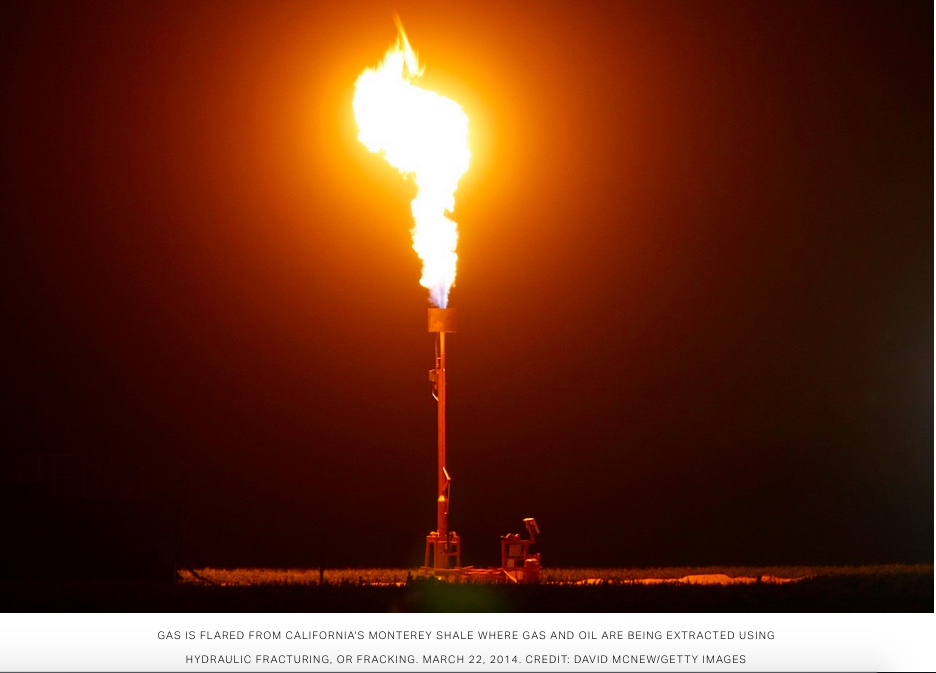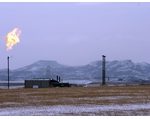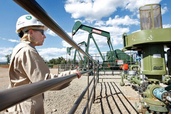
“Natural gas could warm the planet as much as coal in the short term,” as the journal Science itself summed up the 24-author study it just published. Note 1.
But that headline — and virtually all of the media coverage of the study — tells only a piece of the story: The findings confirm if a coal-fired plant is replaced with a gas-fired plant there is no net climate benefit for at least two decades. Note 2.
The missing piece in both the study and the coverage, though, is that countless studies have made clear that natural gas does not just displace dirty coal in the power system — it displaces many carbon-free sources of power, including nuclear and renewables. Note 3.

Natural gas has no climate benefit and may make things worse: Methane leaks in New Mexico’s oil and gas industry equal 12 coal-fired power plants.
Let’s briefly step back from this study to look the three essential reasons natural gas is not a “bridge” fuel to a carbon-free future.
First, natural gas is mostly methane (CH4), a super-potent greenhouse gas, which traps 86 times as much heat as CO2 over a 20-year period. Note 4.
That’s why many studies find that even a very small leakage rate of methane from the natural gas supply chain (production to delivery to combustion) can have a large climate impact — enough to gut the entire benefit of switching from coal-fired power to gas for a long, long time. Note 5.

By The Time Natural Gas Has A Net Climate Benefit You’ll Likely Be Dead And The Climate Ruined
Second, a great many studies have found that leakage rates are not small at all, especially as fracking has become more popular. “A review of more than 200 earlier studies confirms that U.S. emissions of methane are considerably higher than official estimates,” as one 2014 Stanford review research on methane leaks explained. Note 6.
In November, another study found the methane emissions escaping from just New Mexico’s gas and oil industry are “equivalent to the climate impact of approximately 12 coal-fired power plants.” Note 7. In January, NASA found that most of the huge rise in global methane emissions in the past decade was in fact from the fossil fuel industry — and that this rise was “substantially larger” than previously thought. Note 8.
This latest study, “Assessment of methane emissions from the U.S. oil and gas supply chain,” has authors from 16 different institutions, including NOAA, National Institute of Standards and Technology (NIST), Stanford, Harvard, Princeton, and Carnegie Mellon — experts who have co-authored many of the most important studies in this area. See Note 1.
The study found methane emissions are so large, they “produce radiative forcing over a 20-year time horizon comparable to the CO2 from natural gas combustion.” That means the total warming from natural gas plants (leaks plus burning the gas) over a 20-year period is comparable to the total warming from coal plants over 20 year period.
And that brings us to the third crucial point about why natural gas isn’t a bridge fuel. Many other studies find that natural gas plants don’t replace only high-carbon coal plants. Note 9.

Stunning drops in solar, wind costs mean economic case for coal, gas is ‘crumbling’: Things are only going to get tougher for gas and coal compared to renewables
Gas plants commonly replace very low carbon power sources like solar, wind, nuclear, and even energy efficiency, which is often overlooked as a major alternative to fossil fuels.
That effect has been large enough recently to wipe out almost the entire climate benefit from increasing natural gas use in the utility sector if the leakage rate is only 1.2 percent, as one study found back in December 2013 [Note 10], when renewables were far less competitive with gas than they are now. Note 11. But the comprehensive new Science study finds that the leakage rate is 2.3 percent — confirming that indeed the rate is much higher than the estimates used by the EPA, industry, and others.
It’s time to acknowledge that fracking is truly part of the climate problem, and likely to become a bigger problem over time as natural gas competes more and more with renewable energy sources.
Notes:
Note 1. Ramón A. Alvarez, et. al, “Assessment of methane emissions from the U.S. oil and gas supply chain,” Science (21 June 2018). bit.ly/2MOwUkC
Note 2. Leigh Paterson, “Large Methane Leaks Threaten Perception Of ‘Clean’ Natural Gas,” npr (23 June 2018). n.pr/2torc0M
Note 3. Christine Shearer, “The effect of natural gas supply on US renewable energy and CO2 emissions,” IOP Science (24 Sept 2014). bit.ly/2LpH1zp
Note 4. Joe Romm, “More Bad News For Fracking: IPCC Warns Methane Traps Much More Heat Than We Thought,” Think Progress (2 Oct 2013). bit.ly/2v6xT7Z
Note 5. Ramón A. Alvarez, et. al, “Greater focus needed on methane leakage from natural gas infrastructure,” PNAS (24 April 2012).
Note 6. Joe Romm, “By The Time Natural Gas Has A Net Climate Benefit You’ll Likely Be Dead And The Climate Ruined,” Think Progress (19 Feb 2014). bit.ly/2uQ8Uqa
Note 7. Renee McVay, Hillary Hull and David Lyon, “Analysis: Oil an gas Methane Emissions in New Mexico,” Environmental Defense Fund https://bit.ly/2BU90S5
Note 8. NASA, NASA-led Study Solves a Methane Puzzle (2 January 2018). go.nasa.gov/2CXnF0r
Note 9. Christine Shearer, “The effect of natural gas supply on US renewable energy and CO2 emissions,” IPO Science (24 Sept 2014). bit.ly/2LpH1zp
Note 10. Shakeb Afsah and Kendyl Salcito, “Shale Gas: Killing Coal without Cutting CO2,” CO2 Scorecard (2 December 2013). bit.ly/2Lmkp30
Note 11. Joe Romm, “Stunning drops in solar, wind costs mean economic case for coal, gas is ‘crumbling’,” Think Progress (29 March 2018). bit.ly/2q3AWvS
Initially published by ClimateProgress (25 June 2018) at bit.ly/2tWPpvp
Joseph Romm, Ph.D., is one of the United States’ most influential communicators on climate science and solutions. Romm is Chief Science Advisor for “Years of Living Dangerously,” which won the 2014 Emmy Award for Outstanding Nonfiction Series. He is the founding editor of Climate Progress, which New York Times columnist Tom Friedman called “the indispensable blog.” In 2009, Time named him one of its “Heroes of the Environment,” calling him “The Web’s most influential climate-change blogger.” In 2009, Rolling Stone put Romm on its list of 100 “people who are reinventing America.” Romm was acting assistant secretary of energy in 1997, where he oversaw $1 billion in low-carbon technology development and deployment. He is a Senior Fellow at American Progress and holds a Ph.D. in physics from MIT.
Dr. Romm is also author of Climate Change: What Everyone Needs to Know (Oxford University Press, 2015). amzn.to/2J8L1iG
“Climate Change, What Everyone Needs to Know is a must-read for those who want to become climate literate and join the growing conversation about the greatest threat humanity faces today.” –The Guardian


No comments yet, add your own below